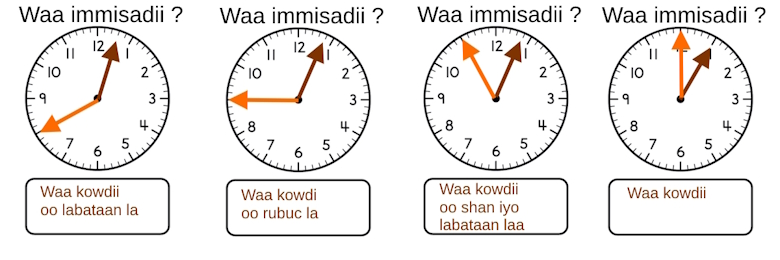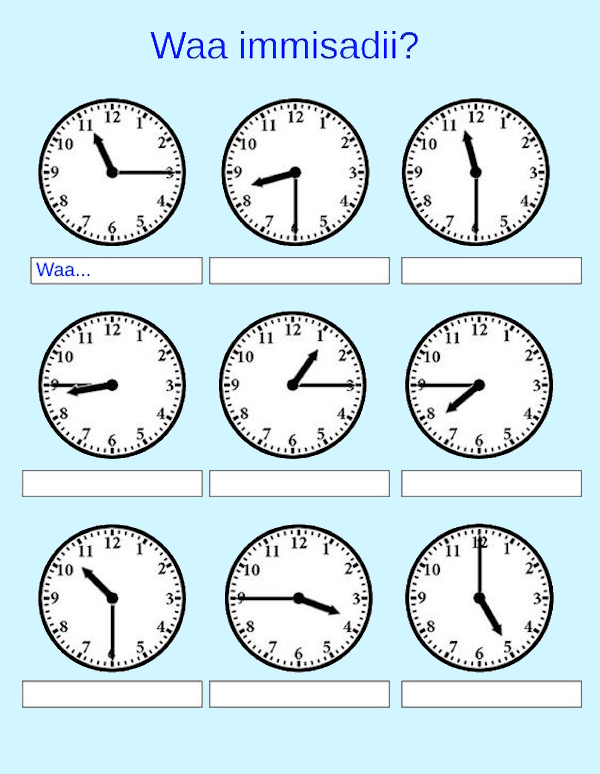 | Chapter 32 - Time, Hour |
|---|
To ask someone for the time, you say: Saacadu waa immisa ? = What time is it? (What o'clock is it?) or simply: "Waa immisadii?" (= What time is it?)
To give the time, you respond (for example): Saacadu waa labadii. = It is two o'clock. (The time is two.), or simply: "Waa labadii" = It is two. (It is two o'clock.) ...
From this example, we notice that the word "hour" is defined as a subject: Saacad -> Saacadu; and that the hour number is also defined, with the proximity suffix -ii!
1. THE EXACT TIME:
| TIME IN SOMALI | Clock | Time in English |
|---|---|---|
| (SAACADU) WAA KOWDII | 01H00 | It is one o'clock |
| (SAACADU) WAA LABADII | 02H00 | It is two o'clock |
| (SAACADU) WAA SADDEXDII | 03H00 | It is three o'clock |
| (SAACADU) WAA AFARTII | 04H00 | It is four o'clock |
| (SAACADU) WAA SHANTII | 05H00 | It is five o'clock |
| (SAACADU) WAA LIXDII | 06H00 | It is six o'clock |
| (SAACADU) WAA TODDOBADII | 07H00 | It is seven o'clock |
| (SAACADU) WAA SIDDEEDII | 08H00 | It is eight o'clock |
| (SAACADU) WAA SAGAALKII | 09H00 | It is nine o'clock |
| (SAACADU) WAA TOBANKII | 10H00 | It is ten o'clock |
| (SAACADU WAA) KOW IYO TOBANKII | 11H00 | It is eleven o'clock |
| (SAACADU WAA) LABA IYO TOBANKII | 12H00 | It is twelve o'clock |
Note:
Since Somalia is located near the equator, there are few variations throughout the year in the hours of sunrise and sunset. The sun rises around 6:00 a.m. and sets around 6:00 p.m.
Threfore, 7:00 a.m. is traditionally considered the first hour of the day = saacadu waa kow!, while seven o'clock in the evening is the first hour of the night = saacadu waa kow!: the traditional "Somali time" is shifted by 6 hours compared to Western time.
This way of telling time is very common in rural areas but is also used in cities, even though clocks and watches are all set to Western time!
Examples:

2. THERE ARE ADDITIONAL MINUTES:
- The word for "minute" is: MIRIR
- The word for "quarter" is: RUBUC or RUBI
- The word for "half" is: BADH or BAR
When there are additional minutes, the word IYO (= and) is used followed by the number of minutes past the hour: iyo shan (= and five) or iyo shan mirir (= and five minutes); iyo toban (= and ten); iyo rubi (= and quarter); iyo bar (= and half).
The additional minutes are mentioned as follows:
| Saacadu waa shantii... | iyo shan mirir | it is five | ...past five |
| iyo tooban(kii) mirir | it is ten | ||
| iyo rubuc(ii) | it is quarter | ||
| iyo badh, bar(kii) | it is half |
Examples:

3. THERE ARE MISSING MINUTES:
From the half-hour, count the minutes missing to reach the next hour. We use the expression:
OO ... LA ... = fewer (= and ... without) followed by the number of minutes missing to reach the next hour: oo labaatan laa (= minus twenty); oo rubi laa (= minus quarter); oo toban laa (= minus ten); oo shan la (= minus five).
Examples:
| (Saacadu) waa sideedii oo toban la | It is ten to eight (o'clock) | (= 8 h minus 10) |
| (Saacadu) waa sagaalkii oo labatan la | It is twenty to nine (o'clock) | (= 9 h minus 20) |
| (Saacadu) waa saggalkii oo rubuc la | It is a quarter to nine (o'clock) | (= 9 h minus 1/4) |
Examples:

4. DIFFERENT PERIODS OF THE DAY AND NIGHT:
Each 24-hour period can be divided as follows:
| SUBAX | from 06:00 | Morning |
| SUBAXDII | from 6 am to 12 pm approximately | Morning |
| GELLIN HORE | morning before 12 pm | Before noon |
| DHARAR | all day | Daytime |
| GELLIN DAMBE | from 01:00 pm | Afternoon |
| GALAB | from 05:00 pm | Evening |
| FIYD | sunset | Dusk |
| HABEN | from 06:00 pm to 5:00 am | Night |
| SAQ DHAXE | 12:00 midnight | Midnight |
| HABEN IYO DHARAR | complete 24 hours | All night and all day |
5. PRAYER TIMES:
| FAJIR | around 5:45 / 6:30 am | Dawn prayer |
| DHUHUR | around 12:00 / 12:30 pm | Noon prayer |
| ASAR | around 3:00 / 5:00 pm | Afternoon prayer |
| MAGHARIB | around 6:00 / 6:30 pm | Sunset prayer |
| CISHA | around 8:00 pm and after | Night prayer |
Practice reading the time:

| Previous Chapter | Next Chapter | Table of Contents |
|---|